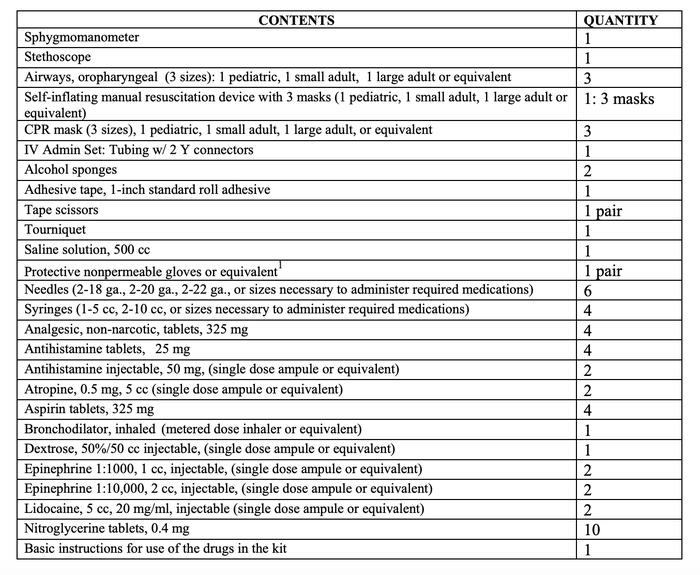This is the written form of a bit of training that I did for the Florida Blogshoot back in March. This is not intended to be a replacement for actual training from a quality instructor. This is a quick summary of what I have been trained to do, trained others to do, and have done during my more than 30 years’ experience as a street medic and educator. This is also not a comprehensive guide to treating gunshot wounds. What this is, is a way to make a difference in a scenario where you are the witness to a person getting shot, first aid, as it were. I hope that it is useful, just as I hope that it won’t be necessary.
You have a limited amount of time to carry out the steps below. A serious wound can cause your patient to bleed to death in less than one minute. If you have the means, practice this skill. You don’t want to have the first time you do it to be when it is needed.
Stop the hazard
When a person is shot, your first priority is to make the scene as safe as you can for yourself, the person shot, and any other rescuers. If on a range, immediately call for a cease fire. If in a violent encounter, return fire. Suppress that incoming, eliminate the others shooting, whatever you need to do to make the incoming fire slack off so that you can get yourself and the victim out of the line of fire and to cover. That includes having the victim fire his weapon at the enemy, if possible.
Call for help. Call 911, call for a medical unit, whatever. You are not gonna want to stay here forever with this casualty. Eventually they will need more care than you can provide. Call for it now.
Quick Assessment
Once the victim is out of the immediate line of fire and help is on the way, do a quick assessment. Where are they shot? How many times were they shot? Are they bleeding? Are the still breathing? If, seconds after being shot, they have already stopped breathing, the OVERWHELMING stats say that no matter what you will do, they won’t make it. Sorry, but those are the facts. Now, if you are not under fire, it doesn’t hurt to do CPR at this point, but if you are in a firefight, performing CPR has just eliminated at least two people from the fight.
If they are breathing, look at where they are shot: the torso, or an extremity? Be thorough. Don’t let the obvious, gruesome wound distract you from one that is less obvious. Don’t overlook the fact that one bullet can leave two holes: an entry wound, and an exit wound. That same bullet can pass through one body structure and strike others. I have seen a bullet pass through a person’s leg, and strike the other leg. Likewise, pass through an arm and enter the chest. Expose the wound area. That means cutting off the victim’s clothes. EMTs are taught to get their patients “trauma naked.” That means strip them down to their underwear (or less, if indicated)
Extremity wounds
If they were shot in an extremity, press a bandage impregnated with a clotting agent (preferably QuikClot, but Celox is also acceptable) to the wound. Press firmly. If the bleeding stops, put a dressing over it, like the Israeli Combat dressing, so that it stays in place. Don’t try to remove the dressing once you get the bleeding stopped- there is a clot there, and we want it to stay in place.
If that Quikclot dressing doesn’t stop the bleeding within 30 seconds, put a tourniquet on the extremity. Quickly. The one that I carry is a CAT. I like them for the ease and speed of use, and I own probably 6 or 8 of these. I have actually used them on people who have been shot, and they work. Place it at least 4 inches closer to the torso than the gunshot wound, if possible. Crank it tighter until the bleeding stops. Yes, it will hurt.
I once treated a woman who was shot 13 times with a 9mm, and had a total of 48 bullet holes in her (some bullets went through both legs). After being shot and left for dead, she crawled to a neighbor’s house and begged for help. I didn’t have enough QuikClot bandages to plug all of the holes, so she got a pair of tourniquets, a handful of trauma bandages, and an air evac. She was rushed to trauma surgery and made a full recovery.
Torso/Neck wounds
If the wound is on the torso (the neck is part of the torso, for this purpose, but the head is not) then you need to be aware of the possibility of air being sucked into the torso. This sets up other problems, so we want to avoid that. Bleeding control is less of a problem, because most bleeding in the torso is going to be internal bleeding that isn’t controlled with pressure or tourniquets.
So in the case of a torso wound, put an occlusive dressing on it. I really like the Hyfin Chest seal. (It comes in packs of two- entry and exit wound, remember?) Just put the center of the dressing on the hole, and press the glue down onto the skin. If the patient has a sucking chest wound, you may have just saved them. If he doesn’t, the occlusive dressing won’t hurt them or make things worse.
The head
So at this point, you might be saying to yourself, “What about wounds to the head?” and that is a great question. Head injuries are tricky, and are even worse when those injuries are caused by high speed projectiles. A gunshot wound to the head is survivable, especially if the bullet doesn’t enter the brain cavity. Many wounds to the face, while disfiguring, are survivable. You can also write a book with all of the things and ways that head injuries need to be treated. I myself have seen a few cases where bullets wrecked teeth, facial bones, and more, but the patient was alive and awake. It can happen.
The main treatment here is to stop the bleeding while making sure that the person’s airway doesn’t fill up with debris: blood, tissue, and teeth can all block the airway and make things tricky. Try to use the Quikclot dressing on facial injuries, keeping in mind that the airway needs to be open.
For God’s sake, don’t use a tourniquet and be careful with the use of pressure because there is a possibility of skull fractures. For that reason, controlling bleeding of the face is a great idea, on the skull, not so much. A person isn’t likely to bleed to death from a skull injury. If a bullet has hit a major artery in the skull, they are more likely to die from other things than they are from blood loss.
As usual, my disclaimer: I have no profit motive or stake in the products that I recommend here. The only reason that I recommend them is because I use them and consider them to be quality products at a reasonable price. I don’t make any money if you buy them, nor does anyone that I know, to the best of my knowledge.
We in the medical field have a tendency to criticize and critique. Before any of my medical brethren take a crack at this post, I ask that you do a couple of things: Review the recommendations of the Committee on Tactical Combat Casualty Care (CoTCCC) and the National Association of Emergency Medical Technicians. They are two of the leading agencies for prehospital care of trauma victims.
QuikClot impregnated Combat gauze is recommended by the CoTCCC and the NAEMT as the first choice for hemostatic dressing of uncontrolled hemorrhage. Celox Gauze & ChitoGauze may be used if Combat Gauze is not available. They worked as effectively as QuikClot Combat gauze in laboratory testing, but neither ChitoGauze nor Celox Gauze have been tested in the USAISR safety model. Chitosan-based hemostatic dressings have been used in combat since 2004 with no safety issues reported.
Since the two largest bodies recommend the use of QuikClot as the first line clotting agent, that is what I recommend when I conduct training.
Remember also that medical doctors and nurses don’t think like prehopsital providers because they aren’t. What happens in the field, especially in situations where bullets are flying, is a completely different kind of medicine than what happens in a hospital.





